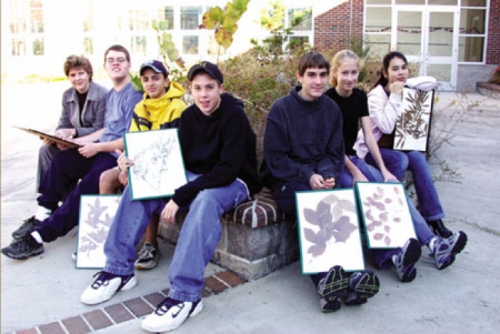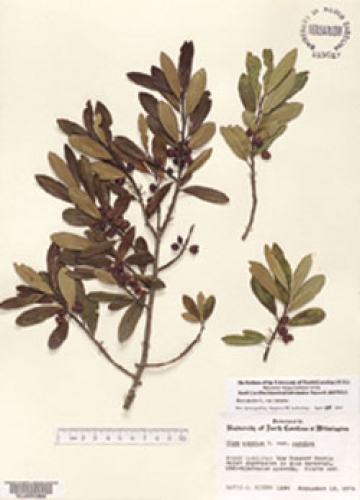As assistant curator of the Southeast’s largest herbarium collection, Carol Ann McCormick keeps busy processing the sundry loan requests that come in. Typically, she’ll gather 200 to 300 specimen sheets at a time and ship them off to the requesting researcher, who will end up keeping them for six months to a year. Recently, though, McCormick came across a bit of an unusual request from a Dr. Werner Greuter of the Botanic Garden of Berlin. It begins:
As you may well know, in 1943 a fire destroyed most of the herbarium holdings of the Botanical Museum Berlin-Dahlem (BGBM). In the same time, we lost our entire herbarium loan records, which unfortunately made it virtually impossible for us to retrieve outstanding loans.
The request goes on to say that some fungi specimens sent from Berlin to Chapel Hill before 1938 to John Couch, a famous botanist and Carolina professor, may still be out on loan to UNC.
McCormick says, “Of course when you read this, you realize that he’s being tactful when he says it was a fire. You see the date, and you know he’s talking about World War II. Apparently the herbarium was right in the center of the city, so the whole building was destroyed, along with the whole museum. The only things that survived were those things out on loan.”
Loaning specimens is vital to an herbarium’s collection. “If we didn’t loan out our specimens, we wouldn’t have enough space to store all of them,” McCormick laughs. Seriously though, McCormick explains that since no herbarium or museum has a staff of experts on all groups of plants, it’s important for specimens to get reviewed by an expert, whether that expert is 20 miles or 2,000 miles away.
Unlike library books, specimen sheets are meant to be written on. Each reviewer makes annotations, and attaches them directly to the sheets themselves. That way future reviewers know who has studied the specimens before, and the knowledge base about a particular specimen continues to grow.
Each specimen includes information such as the plant’s scientific name, the name of the person who collected it, and where it was found. Researchers can use the specimens to show, for instance, how a plant species has changed over time. DNA can even be harvested from specimens and used in the development of evolutionary trees. Other uses include environmental planning, identifying plants for poison-control centers, verifying new weeds, and confirming illegal plants for law enforcement. Wildflower lovers and horticulturalists can also use the specimens to identify trees they see on their property and in parks and other natural areas.
As it happens, McCormick has found some specimens she believes belong to BGBM. Greuter had thought it likely that Carolina had the specimens because Couch had written a paper, published by UNC Press in 1938, that made reference to and cited some of the specimens from BGBM.
But it’s a bit unclear as to how many of the specimens actually belong to Berlin and how many belong to Carolina. “Those stamped ‘Mus. Bot. Berol.’ clearly belong to Berlin, but then there are some with Couch’s handwriting that say ‘from Berlin,’ so I don’t know if those actually belong to the museum in Berlin or if he means it’s a specimen taken from Berlin,” McCormick says. So McCormick will digitize the images, e-mail them to Greuter, and then the two of them will hash out which ones belong where.
“This really is a breaking news story,” says Peter White, professor of biology and director of the North Carolina Botanical Garden (NCBG), which oversees the herbarium. “It’s not every day that you come across a piece of an irreplaceable collection you thought was completely lost.”
Currently, the University of North Carolina Herbarium, which holds more than 660,000 specimens, is housed in metal cabinets that line the hallways of Coker Hall. “But a museum collection doesn’t do the public any good if it’s locked in cabinets and hard to get to,” White says. “What we want to do is make the herbarium more accessible to the public.”
In July 2000, the UNC Herbarium officially became part of the NCBG. Plans are in the works for a new building to house the collection, but the NCBG is still awaiting legislative appropriation. So in the meantime, White and colleagues Evelyn Daniel and Jane Greenberg of the School of Information and Library Science (SILS) are creating an electronic version.
With a couple grants, including one from the late Chancellor Michael Hooker’s technology fund, the herbarium purchased a video camera for creating specimen images and produced a virtual library of North Carolina trees including gymnosperms (pines and their relatives) and angiosperms (flowering plants) in the Southeast.
Another grant in conjunction with SILS enables the herbarium to work with McDougle Middle School and the Orange County Public Library on a tree identification project. Students use the virtual library of North Carolina tree specimens to identify specimens they have collected from the woods, from the school site, or from their backyards.
“There’s no perfect book for the Southeast for identifying trees,” White says. “And the books that are out there typically do not have real specimens, so it’s hard to make a judgment based on a picture or a line drawing. The web site helps solve that problem, and it brings university expert verified knowledge directly to the public.”
While the on-line version benefits the students, the students are also helping the herbarium by pilot testing the web site. “If kids can get through the web site, then it’s going to be user friendly for the general public,” says Priscilla Dennison, a science teacher at McDougle Middle School.
Additionally, students see what it might be like to be botanists. They are able to look at professionally annotated specimens, and they learn how to collect, observe, and identify a plant, as well as make specimen mountings of their own.
“I know some of my students will go back to the web site,” Dennison says. “A few of them may even decide to continue their study of botany using the tools of identification they now have at hand. The feedback from the kids was excellent.”
Eventually the herbarium will add other groups of plant specimens to its virtual collection. Right now, there are around 1000 specimens on-line. “We’re trying to post the specimens in blocks that are useful all by themselves, like pines or fungi, so that people don’t have to wait until all of the specimens are up before they can use the site.” White says.
“Ultimately, our goal is to blur the line between university knowledge and public knowledge, so that people can have ready access to a huge storehouse of information that is not usually used by the vast majority of people.”
Catherine House was formerly a staff contributor for Endeavors.
White participates in the Carolina Speakers Program; for information, see www.unc.edu/depts/uncspeak/. Visit the virtual library at http://www.ibiblio.org/pic.




